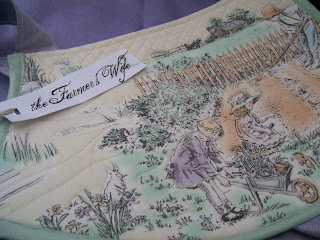
As I stood in my kitchen with bed-head hair, in a slack-fitting pink floral summer spaghetti strap nightgown covered up with my lilac purple apron that depicts two children in a garden, my thoughts were on fire. I was thinking about the flour I was using - King Arthur Flour to be exact - and how they are an employee-owned company. That all of the King Arthur Flour is grown by farmers in the United States, making the product a little closer to home. I was thinking about the bread-making skills I've learned whether from watching my mother when I was young or reading online in the twenty-first century, and thus the various ways by which I've learned how to feed myself. I was thinking about how these skills are spread out, not ubiquitous in my nation, one that truly and almost obscenely depends on the unknown world of industrial production to come up with and market food stuffs (along with water and clean air to breath are the foundation of each day of living).
If you can imagine my kitchen this morning:
A small, two-sided room with counters and appliances lining the two walls and a window at the end between them. On the right is the sink, halfway down, and in the space to the right I had my laptop computer on and open to my Facebook page and the King Arthur Flour Parker House Rolls Recipe. To the left were a half-gallon of Snowville Creamery whipping cream, a bowl with a fork, and my small food processor. I was pouring cream into the processor about two cups at a time, and pressing the chop button with my left thumb to get the fat concussion started that would make butter out of cream, while scanning Facebook for the ever-important updates with my right hand and trying to respond to comments with peck-like typing.
On the left is a portable dishwasher next to the counter that is followed by the stove then fridge. On the dishwasher was the dough rising bucket that held what I had already made-up - the dough for Monika's bread recipe on the KAF website, and it was rising slowly, boringly. With little faith in that dough, I figured I should make something else in case Monika's didn't work out, and went on to make the Parker House Rolls dough. And that is why I started to make the butter - I was out of butter and milk that the recipe called for, so I got both products, quickly, because of the little machine that churned.

I find this interesting. In order to make the dough, I needed a solid fat and a liquid, both of which were in the whipping cream but which had to first be separated from each other in order to be employed in the recipe. The milk softens and gathers the flour, while the fat provides richness, flavor, and if from pastured cows, a lovely yellow color and vitamins. How do we know this? Who figured out that there is fat in cows milk, and that through a process of concussion where the imperceptible fat globules can be knocked around and forced together, one could get the solid fat called butter? I don't know who, and I also don't know where I would have found out about this process if I didn't have the Internet. If I had asked the people I know how it works, my mother may have been the only one to have an answer, and that at least partly stems from trying to make whipped cream and accidentally going beyond the whipping stage. You get butter and milk.
Most people, though, are so alienated from food that it is no wonder knowledge is limited. When Home Economics as a field of study was no longer found necessary on a large scale because everything we eat could be bought, skills were sadly lost. Now this is not a new social and economic occurrence. In the early 1900s, farm women were being encouraged to "learn how" to make cheese, a woman's skill once so prevalent and even necessary had been lost due to the industrialization of cheese in the 1800s. When dairy production was on the rise but dairy use was in a slump around 1920, the organized dairy industrialists with the support and promotion by the USDA, set out to get women, especially farm women, to learn how to make cheese again. Well, without such developments, the price of dairy would have kept sliding and farmers would have been hit harder than ever.
Now the funny thing was - okay it wasn't funny - that before cheese was industrialized, and farm women and women in general were the main cheese-makers, consumption was high. Consumption of cheese plummeted after industrialization - it wasn't trusted, didn't taste as good, and I would argue that it was alienated from the culture. Cheese-making was a cultural characteristic and practice, and within the context of farm and home was richer because it was done with necessity. When a food is industrialized, is the importance of the food lessened? What is the human culture around industrial foods?
What I'm certain of is that my butter, churned by a machine running on electricity in my kitchen was encompassed in a shared space with my computer and online banter, with my younger cat rubbing on my legs for attention, while the Spanish-speaking man who was in the hall cleaning the entryway to my building had a lively conversation on his cell phone, will be non-alientating in the context from which it was brought forth. The land, the grass, the cows, the small dairy factory, the milk retailer, my car, the fuel, the grocery bags, the time, the sun, the wiring, the lighting, the know-how - these are the things that I'll spread on my next slice of toast.

No comments:
Post a Comment